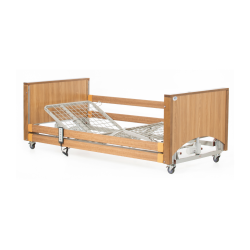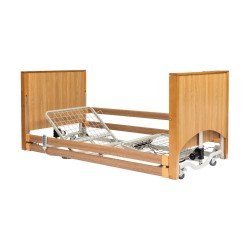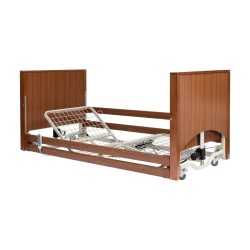Low Profiling Beds
There are 4 products.
Active filters
About Low Profiling Beds
Ultra-Low Beds for Falls Prevention and Enhanced Safety
Low profiling beds provide specialised adjustable sleeping surfaces featuring ultra-low minimum heights specifically designed for falls prevention across care homes, hospitals, and care settings throughout England, Scotland, Wales, and Northern Ireland. These specialist care beds achieve significantly lower minimum heights than standard profiling beds typically descending to 200-250mm from floor to bed deck, dramatically reducing fall consequences if patients roll or climb from bed. Care environments utilise low profiling beds for residents or patients with high falls risk including those with dementia, confusion, or impaired mobility, individuals with history of bed falls, patients requiring frequent night-time bathroom access, confused individuals attempting unsafe independent mobilisation, and residents for whom bed rails are inappropriate or refused. Modern low profiling beds incorporate features including ultra-low positioning reducing injury risk, standard profiling functionality including backrest and leg elevation, variable height adjustment enabling care delivery at appropriate height, robust construction supporting patient weights, and safety features including automatic height limitation preventing excessive raising when side rails are lowered. The provision of low profiling beds demonstrates commitment to falls prevention through environmental adaptation, supports person-centred care enabling dignity without restrictive interventions, and enables comprehensive safety management across care environments.
The implementation of low profiling beds directly supports CQC compliance through proactive falls prevention, reduced fall-related injuries, and demonstration of person-centred safety approaches prioritising dignity over restriction. Falls from bed represent serious incidents causing injury including fractures and head trauma, whilst bed rails pose alternative risks including entrapment. Low profiling beds address these challenges by dramatically reducing fall distances minimising injury severity if falls occur, enabling bed height adjustment for different activities with low positioning during sleeping and raised height for care delivery, providing non-restrictive falls prevention maintaining dignity, and supporting progressive independence by allowing safer independent movement. Clinical applications include dementia care for residents attempting unsafe night-time mobilisation, general falls prevention for high-risk residents, post-fall care reducing re-injury risk, palliative care enabling safe bed access, and situations where bed rails are inappropriate or refused. Care organisations benefit from low profiling beds through reduced fall-related injuries decreasing harm and associated costs, enhanced CQC ratings through effective falls prevention, improved resident and family satisfaction through dignified safety provision, and reduced restrictive practice through alternatives to bed rails. Modern low profiling beds incorporate advanced features such as programmable height limits, integrated floor proximity sensors, and robust construction throughout England, Scotland, Wales, and Northern Ireland.
Selecting and implementing low profiling beds requires comprehensive falls risk assessment, appropriate bed specification, and integration with multifactorial falls prevention strategies across care facilities throughout the UK. Organisations should conduct individual falls risk assessments identifying residents requiring low beds, evaluate bed characteristics considering minimum height achievements with some models reaching 200mm, assess care requirements ensuring beds maintain necessary functionality, and calculate bed quantities based on high-risk resident numbers. Bed selection should prioritise ultra-low minimum height typically 200-250mm, maintained profiling functionality enabling backrest and leg elevation, adequate maximum height for care delivery typically 600-700mm, appropriate safe working load, and additional safety features such as floor proximity alarms. Implementation protocols must encompass comprehensive staff training on low bed use including appropriate residents, height management, and integration with care plans, individual care planning documenting bed provision and falls risk management, and environmental adaptation including floor padding around low beds. Quality assurance measures should include falls incident monitoring evaluating prevention effectiveness, regular bed maintenance, review of low bed appropriateness as resident conditions change, and documentation demonstrating falls prevention efforts. Modern low profiling beds may incorporate features such as under-bed lighting, integrated exit alarms, and battery backup. Organisations should establish protocols for low bed allocation based on falls risk assessment, integrate with comprehensive falls prevention strategies including environmental safety and mobility support, and maintain documentation. Care plans should document low bed provision, associated safety measures, and review schedules. Staff education should address low bed purposes, appropriate residents, height management protocols, and recognition that low beds complement rather than replace comprehensive falls prevention. By implementing low profiling beds alongside professional falls prevention protocols, care organisations throughout England, Scotland, Wales, and Northern Ireland demonstrate their commitment to CQC standards, proactive falls prevention through environmental adaptation, resident safety and dignity through non-restrictive approaches, and evidence-based falls management reducing injury risk whilst supporting independence across care environments serving vulnerable populations.




